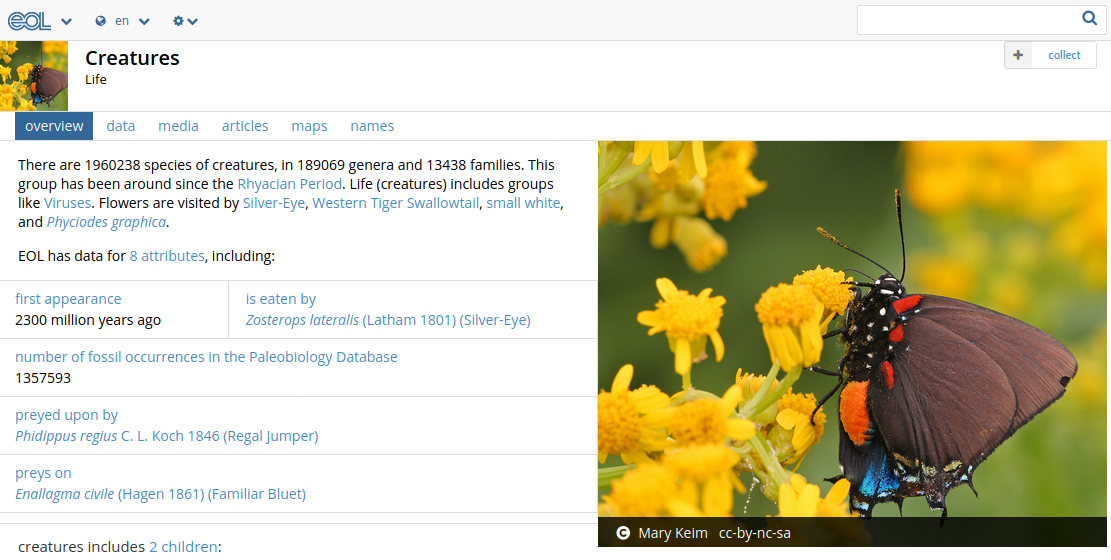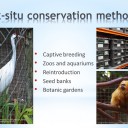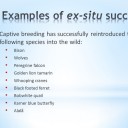Conservation methods
 In this activity students research a local example of captive breeding to explore the issues around ex-situ conservation and reintroduction of endangered species. Simple explanatory slides compare in-situ and ex-situ conservation methods and the important bio-geographical aspects of nature reserve design. An IB style question completes this activity.
In this activity students research a local example of captive breeding to explore the issues around ex-situ conservation and reintroduction of endangered species. Simple explanatory slides compare in-situ and ex-situ conservation methods and the important bio-geographical aspects of nature reserve design. An IB style question completes this activity.
Lesson Description
Guiding Question
- What is the best method of conserving an endangered species?
- Why are conservationist resorting to captive breeding and release rather than insitu conservation?
Activity 1 - Research a captive breeding programme local to you
The captive breeding of a species is a process which aims to achieve a population size large enough to allow, through reintroduction its re-establishment in one or more of the areas where the species was historically distributed.
There are a number of data bases used by biologists which catalogue endangered species, and captive breeding programmes.
Step 1 - Find an endangered species local to you
Use the IUCN Re-introductions directory first to find a captive breeding programme local to you,
Alternatively click a point on this Alliance for Zero Extinction (2010). 2010 AZE Update. www.zeroextinction.org
Remember to write down the scientific name of the species.
Step 2 - Research your species' conservation status on the IUCN Red list.
Use the IUCN Red list to find the conservation status of your species
Step 3 - Research further details on one of these Biodiversity databases.
The Biodiversity Heritage Library (BHL) is a consortium of 12 natural history and botanical libraries that cooperate to digitize and make accessible the legacy literature of biodiversity held in their collections and to make that literature available for open access and responsible use as a part of a global biodiversity commons. BHL also serves as the foundational literature component of the
The Encyclopedia of Life works with educators, citizen scientists and partners to make this information accessible through free tools, services and resources found here.
GBIF—the Global Biodiversity Information Facility—is an international network and research infrastructure funded by the world’s governments and aimed at providing anyone, anywhere, open access to data about all types of life on Earth.
The Catalogue of Life is the most comprehensive and authoritative global index of species currently available. It consists of a single integrated species checklist and taxonomic hierarchy. The Catalogue holds essential information on the names, relationships and distributions of over 1.8 million species
Step 4 - Use this information to complete an infographic
This Captive breeding Powerpoint template makes a great starting point for a captive breeding infographic.
You get to worry about the content rather than the layout, which saves time.
Here is an example of an infographic about a captive breeding programme local to me.
Activity 2 - Consideration of in situ conservation vs ex situ conservation
The slides below cover these points
- Active management of nature reserves or national parks is called In situ conservation.
- Outside their habitat, Ex situ conservation preserves species.
Key questions
- Define In-situ conservation.
- Distinguish between in-situ conservation and ex-situ conservation.
- Describe corridors in nature reserve design.
- Explain why edge effects can reduce the ecological value of a nature reserve.
Activity 3 - IB style question
Answer the following ![]() Conservation methods IB style questions about conservation methods
Conservation methods IB style questions about conservation methods
Teacher's notes
This lessons begins with students researching a local example of captive breeding. There are many good examples and they illustrate the key ideas about the benefits and costs of captive breeding as an example of ex-situ conservation. This could be an investigation individually or for students in groups. The Powerpoint slide link can be downloaded and edited, but of course other formats are possible too.
The slides resume the main points and the questions which go with them are really for discussion, or note taking purposes.
The last activity are some simple IB style questions.
Model answers,
Interesting links to case studies of in-situ and ex-situ conservation
Willie Smitts - conserving Orangutans using a method to re-grow clearcut rainforest in Borneo
Green is by far the greatest film ever made about orangutans, palm oil and deforestation. It was filmed in Borneo and Sumatra and on location at the BOS Nyaru Menteng Orangutan Rescue
Forest regeneration - seed and sapling collection in Tanjung Puting National Park, Borneo
Montseny brook newt - a recently discovered species in northern spain
AZA guide to reintroductions - interesting information about some well known species
USDA Planning and design principals in nature reserve design - a great summary of the key issues

 IB Docs (2) Team
IB Docs (2) Team

















